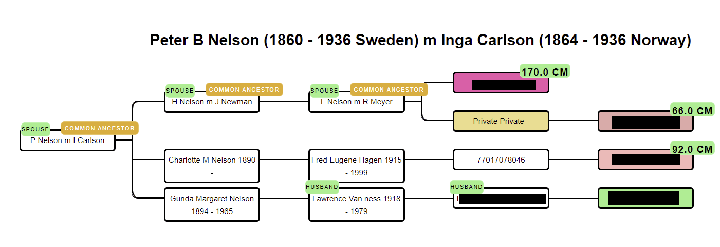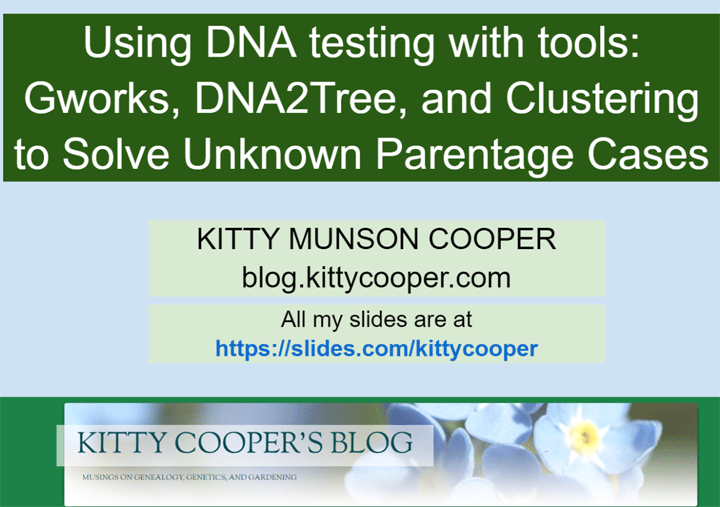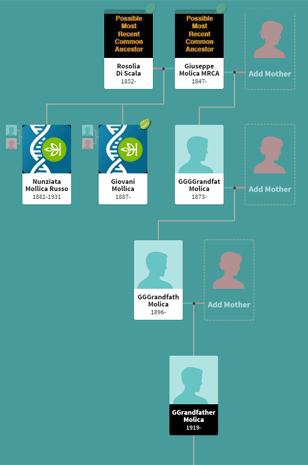Tuesday I will be presenting the latest version of my talk on solving unknown parentage cases in a virtual conference hosted by the Utah genealogical society (click here for more information). In the past, I relied heavily on the tools at DNAgedcom, but now there are several new tools that are even more exciting.
The basic methodology for unknown parentage searches is to DNA test everywhere. Then look through the trees of your matches to see what ancestors are in common. Build trees down from those common ancestors looking for where the different families meet in a marriage. Then find a child of that marriage who was in the right place at the right time to be the missing parent or grandparent or …
A major difficulty is that many people test DNA without providing a tree. Usually you have to try to build trees for them. Another problem is that building trees down from those common ancestors is incredibly labor intensive when the families are large and the matches are distant. My latest strategy for difficult cases is to recruit several search angels to build the different trees.
There are now tools that automate building trees!
DNA2tree will build trees at Ancestry of your matches down from the common ancestor. Sadly it is only available on iPhones and iPads although an android version is in the works. Did I break my android tablet on purpose so I could buy a slightly used iPad? No, but maybe it was a Freudian slip… I love this app! I had a guest blog about it a while back but soon I will describe my own adventures using it, as an inept iPad user.
Of course, the trees it builds only include the lines from the common ancestors down to your matches plus a possible one to you with just the names GGgrandfather and so on. They are as error ridden as the ancestry trees they are based on, so they often need much work. Still it is an incredible time saver. I like that it uses special icons to indicate the ancestors of your DNA matches as well as showing the probable common ancestors with those words on a black background, sample on the left.
Clustering is the other big game changer. When those DNA matches with no trees are clustering with people who do, it becomes possible to figure out where they fit.
One of the best clustering applications is from the Genetic Affairs site because it will cluster a number of subsets for you, including just starred matches. My blog post on that site (click here) was written before all those enhancements. DNA2tree, GEDmatch, DNAgedcom, and MyHeritage all have clustering applications too.
Guess what, Genetic Affairs will build some trees now!! Although they look like the one below, rather than being built at ancestry for you. Still the compact nature of the display makes it easier to see how the DNA matches are descended from your common ancestor.

A tree created by Genetic Affairs showing the common ancestors in a compact diagram with the DNA matches
Every tool has its advantages but none of these tools are free. Click here for the slides from my talk. I am still reworking them because so many screens have changed!
Disclaimer: I have been given a free trial with DNA2tree to evaluate it. DNAgedcom has given me a free search angel account. Genetic Affiars I have been paying as I go for.


Thank you for this great information. I have tried DNA2Tree on my ipad and phone. Can’t get it to build a tree! I did get a list of name but had many of them and not sure how to continue. I think I will wait a few weeks and try again.
Well my slides may help or my next blog post. Typically I click on a common ancestor from the list and then on the next page, top right, I click “Build” to create the tree.
There is a user guide here: http://dnadreamers.com/wp-content/uploads/2019/04/DNA2Tree-User-Guide-1.0.pdf
Hi Merrikay,
If you email me at davidneal@dnadreamers.com I will help you to build a tree.
David Neal
Developer DNA2Tree
Yes please. I am trying to find the relationship between myself and a 13 year old female. I know the name of her parents and some of hte other relations. What next please
Valerie –
Typically you would build her a tree based on what is known back several generations and then look for how it relates to your tree.
Ancestry is an easy place to do that because of all the tree hints they give you. You could also try FamilySearch.org or GENI or WIKItree, all of which are one world trees, so one profile for each person. They have the advantage of being free.
You might find my unknown parentage slides useful as well:
https://slides.com/kittycooper/using-dna-for-adoption-searches-28-34-41#/
What has happened with. Ancestry DNAHelper. I used satisfactorily a year ago but since have not been able to engage. On ancestry DNA match page it briefly pops up but goes away??????
Randall –
I actually removed the AncestryDNA helper months back. My theory was that I had too many chrome addons and they were causing me problems at Ancestry. These days I use firefox to access Ancestry instead.
The developer of AncestryDNA helper responds to questions on his Yahho group at: https://groups.yahoo.com/neo/groups/AncestryDNA_Discussion/conversations/messages
Note that these discussion groups are not closing down, rather Yahoo is no longer supporting a files section
Randall –
By the way, I use the paid DNAgedcom gathering program to collect all my matches now. I find those spreadsheets very useful.
I’m excited about 23andme.com’s new family tree beta that just showed up today. It’s got some more work to do, but as far as testing companies family tree products, it’s the first to suggest potential match placement. I’m impatiently awaiting to see their next update.
P.S. I too would like to see the android version of the DNA2tree app. It sounds very Interesting.
DNA PAINTER now has a nice TREES app with more functionality coming “soon” to connect the centimorgans to people in the tree. Their WATO (What Are The Odds) tool is also very useful.
I’ve been working on a third party DNA tools presentation and after several days of working on the PowerPoint, DNA PAINTER up and changed their main menu pages today……. arrrrgggg. Back to editing! Also, another little known DNA PAINTER tool for those who like to work with spreadsheets is their CLUSTER FORMATTING TOOL. It will take the cluster format from Genetic Affairs or MyHeritage clusters and put it in a CSV format for manipulation. Thanks for the info on DNA2TREE.
Debbie,
You feel my pain perfectly. I gave a version of this talk in June but almost every screen shot is out of date plus of course I added a more detailed section on DNA2tree now that I have it. I am almost finished with my updates!
I listened to your presentation last night and really enjoyed it! So many great avenues to save time. Thanks so much!
Thanks so such for the comment Teresa. It is strange delivering a talk to an audience I cannot hear or see! So nice to know it was enjoyed.
Thanks for sharing, Kitty! And, this field does change incredibly fast. I need to spend some more time looking at some of these tools. Thanks for sharing your slides, too!
Apple released the latest update to its OS today, named Catalina. Apparently it includes functionality called Catalyst that allows developers to easily port iPad apps to the MacOS. Might it soon be possible to run DNA2Tree on a Mac rather than an iPad?
Hi Michael,
I have been following closely the news of Catalina and hoped it might provide an easy path to getting DNA2Tree to the Mac. But it turns out to not be so straightforward. DNA2Tree goes through the iOS App Store for purchases. Getting DNA2Tree to work on Catalina requires it to be converted to the Mac App Store. It isn’t a large amount of work, but it just doesn’t happen for free.
I am exploring different ways to get DNA2Tree to the Mac as I am a longtime Mac user and I would love to use it on a Mac myself. Hope to have a solution this year.
David
Thanks, the slides are really precise and insightful. I’m amazed with progress of customer genetics in the last decade. Can’t wait to see what will happen in the next years.
Kitty, I am trying to further prove the parents of one of my maternal double great grandmothers. I have been using GEDmatch and triangulating the DNA of my sister and myself with probable siblings of my likely triple great grandfather. In several of the triangulations, my sister and I have exact matches on multiple chromosomes with the probable sibling, but the centimorgans are at the level of 3, 4, 5, and 6. I am wondering if matching exactly at those levels is real or not? thanks Bill
Sorry anything less than 6 cM is likely false and about half of the 6cM matches are also false. Read this to gain more understanding of why that is so
http://blog.kittycooper.com/2014/10/when-is-a-dna-segment-match-a-real-match-ibd-or-ibs-or-ibc/
Kitty, Once again, thanks so much for your help. I will keep working on this. Perhaps I am looking at cousins and not siblings. We do have a match in Family Tree of a probable sibling that is 21cm. The problem with Mason County, VA later WV is that many family groups are not
completely researched and records are scanty at best. We are also starting at a deficit since nothing of the family or origins of our double great grandmother were known until recently. thanks again, Bill
Get as many cousins descended from her probable parents to test as possible.
Another idea. If you have a cousin in the direct female line of descent from her and can find someone in the direct female line of descent from her probable mother then do full mitochondrial tests for each one. The tester can be a male but has to be descended only on the female line. If they match, that would be as close to proof as you can get! Many tests at ftDNA are on sale now through Thanksgiving. Use my affiliate link to buy those tests https://affiliate.familytreedna.com/idevaffiliate.php?id=1529_0_3_5
Kitty, Thanks and that is my plan. I had my sister do her full mitochondrial test last year at FT. She is a direct female line to our double great grandmother, Margaret Jeffers, and her probably mother, unknown McGuire, and then Mackley and then Ogan. Her mitochondrial DNA is rather rare, H15a1b, so I am guessing that that should help with any confirmation. FT says that Scotland is a site for significant cases of H15a1b. I just need to find the right descendant and see if they are willing to do their DNA. thanks again, Bill
Hi Kitty,
I really enjoy reading your blog! I have a question about the length of matching segments that are reported by the various testing/matching companies. I did the Ancestry autosomal DNA test and have recently uploaded my data to Gedmatch and FTDNA. It is very surprising the variation in what those 3 comparisons give for the same match! Ancestry says we match 23 cM across 3 segments; Gedmatch says 37.7 cM with the longest segment being 37.7 cM: FtDNA says 74 cM shared with 38 cM being the longest. What?! My DNA data is the same on all 3 sites and since Gedmatch does’t do testing, I assume the DNA data for my match was identical on all 3 sites. How is this difference possible, and how can I tell which value is “correct?” Thank you!
Hi Trudy,
First understand that the companies keep changing the chip they use for testing in an effort to get more accurate results (specifically for ancestry composition since the early chips were very euro-centric), So comparisons between different chips lose some accuracy…
Plus Ancestry removes matching DNA that they deem population specific in their report. GEDmatch has a template that makes comparisons possible between companies, so probably that is the best comparison, if you look at the one to one. Family Tree DNA includes many small segments that most, but not all, find less useful. Finally, MyHeritage has a different way to make up the differences…
So no, the DNA data used is not exactly identical even though it is the same set of test results.
Thank you! I’ll put more stock in GED match, then!